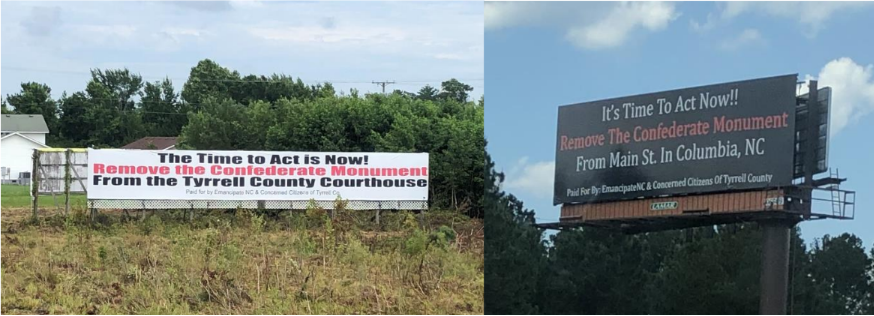For the past year, Emancipate NC has worked to support the efforts of the Concerned Citizens of Tyrrell County, an organization of Black community members in North Carolina’s smallest county by population, located in the northeastern part of the state. Since 2020, the Concerned Citizens have sought to persuade local officials to remove a monument to Confederate Soldiers and “Faithful Slaves” that sits in front of the Tyrrell County’s Courthouse. Earlier this summer, our organizations jointly erected a pair of billboards on I-64 E, calling on the elected county commissioners to remove the monument from courthouse grounds. In the intervening months, county officials have been largely silent on the matter, seemingly reluctant to mount a substantive defense of the monument. On the rare occasion that they have spoken, it has been to direct people’s attention to a 2015 monument preservation law passed by the General Assembly, which purports to prohibit local officials from taking action to remove such monuments.
At the Commission’s October 4, 2022 meeting last week, Emancipate NC attorney Ian Mance spoke directly to the County Commissioners, delivering remarks alongside Mark Mixon and Joyce Fitch, President and Secretary, respectively, of the Concerned Citizens of Tyrrell County. A portion of Ian’s comments are reprinted below:
. . . In the letter we sent to the Commission last month, we noted “this monument has the distinction of being one of the only remaining monuments on public property in the United States to mention or depict slaves.” Since that time, I’ve had an opportunity to do further research, and I believe it’s the case that this is likely the only monument to mention slaves at any courthouse anywhere in the United States. . . . I’m aware of only one other similar monument on public property, in Fort Mills, South Carolina, and it’s in a park, not at a courthouse. . . .
I say this to reinforce how unique Tyrrell County’s courthouse monument is. To the extent legal challenges are likely to be successful against county governments that choose to maintain Confederate monuments—and there are a number of cases ongoing right now—Tyrrell County’s monument may be the most vulnerable, because of the uniqueness of its message and its location. This is a monument that projects a racially hostile message at a courthouse, in contradiction of the idea that court should be a place where people can expect to get equal justice under the law.
One of the most comprehensive articles that’s been written about these remaining faithful slave monuments discusses the monument here. It says the placement “on the grounds of the Tyrrell County Courthouse [in 1902] was intended to send an ominous message to every Black person with the misfortune of seeking justice in its halls.” So this is unambiguously a pro-slavery, anti-civil rights monument. The historical record suggests it was erected to convey to Black people that they could not get justice at that courthouse.
This Commission should remove this monument. The [U.S.] Supreme Court has said that monuments on government property are government speech. And you are the government here. As a legal matter, this monument is speaking for you. It’s communicating a message on your behalf. And you have every right to communicate something different. More than a dozen commissions in this state have voted to move monuments in their communities since the passage of the monument preservation law. As we noted in our letter, the courts have really curtailed the application of that law, so as a legal matter, it does not present a serious obstacle to you acting to address this.
We ask you to seriously consider this request. . . . We need to know where you stand. The community organization that the folks here belong to has been trying for a number of years to bring this to your attention—through direct appeals, protests, newspaper articles, billboards, and letters. They’ve had a lot to say. We need to hear from you.
Following the presentation, Nina B. Griswell, the Vice Chair of the Commission, departed from the Commission’s characteristic silence on the issue and implored to the board to address the issue, stating that it must “decide one way or another: Are we against or for the monument?” She continued by noting, “This issue is not going to go away; it’s not going to go away,” and proposed that Commissioners hold a public hearing on the matter in the near future—“something to talk to the community as a whole.” While no commissioner voiced objection to the proposal, the Chair of the Commission, Nathan T. Everett, asked if the Board could first meet in private to receive legal advice from the county attorney.
Griswell asked the county’s attorney to provide the Board with a legal opinion in response to Emancipate NC’s assertion, in an August 16, 2022 letter, that “the N.C. Court of Appeals ha[d] significantly curtailed [the monument preservation law’s] application,” and held “that a County Commission’s decision to remove a monument cannot be said to violate ‘any . . . legally enforceable right . . . sufficient to convey standing’ to third parties who might wish to challenge that decision.” Griswell asked the county manager to “research the law and tell us what we can and cannot do.” Then, she said, “we as a board, we need to vote—one way or another, whether it’s for or against it—because this is not going to go away.”
